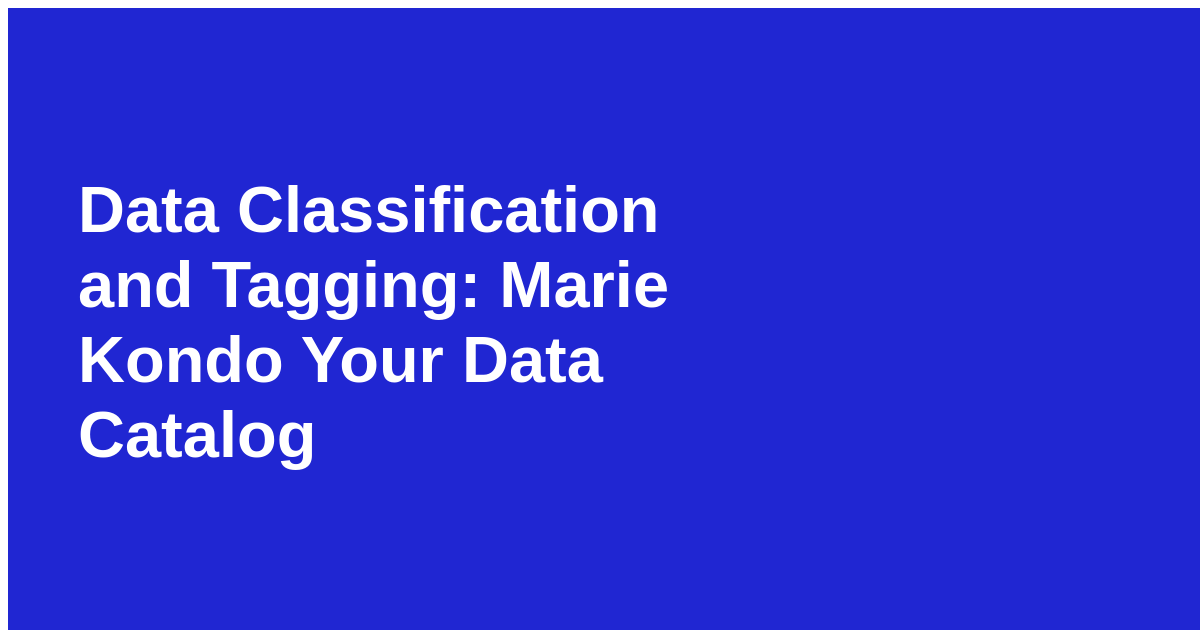Data tagging is the process of adding metadata to your file data in the form of key value pairs. These values give context to your data, so that others can easily find it in search and execute actions on it, such as move to confinement or a cloud-based data lake. Data tagging is valuable for research queries and analytics projects or to comply with regulations and policies.
References
-
 Data classification and tagging is essential to decluttering your data estate, understanding what data you have, and using it properly. Explore the benefits, techniques, and tools.🔗atlan.com
Data classification and tagging is essential to decluttering your data estate, understanding what data you have, and using it properly. Explore the benefits, techniques, and tools.🔗atlan.com -
 In previous posts, I discussed the source of data and how data oceans can democratize our AI experience. But that is not the entire story. I am writing these pieces to illustrate how AI can help us…🔗Medium
In previous posts, I discussed the source of data and how data oceans can democratize our AI experience. But that is not the entire story. I am writing these pieces to illustrate how AI can help us…🔗Medium -
 Data classification and data tagging will kick off your program so you know exactly what your data is and how it impacts the business.🔗Sonrai | Enterprise Cloud Security Platform
Data classification and data tagging will kick off your program so you know exactly what your data is and how it impacts the business.🔗Sonrai | Enterprise Cloud Security Platform -
 Tagging data for machine learning and its applications.🔗What is the purpose of tagging data?
Tagging data for machine learning and its applications.🔗What is the purpose of tagging data? -
 Data tagging is the process of adding metadata to your file data in the form of key value pairs. Learn more about unstructured data tagging and Smart Data Workflows.🔗Komprise
Data tagging is the process of adding metadata to your file data in the form of key value pairs. Learn more about unstructured data tagging and Smart Data Workflows.🔗Komprise -
Learn what are the most effective data classification and tagging techniques for data governance and how they can enhance your data security, quality, compliance, discovery, analysis, and integration.🔗linkedin.com
-
by Andrew AJ Forysiak In today's data-driven world, accurate data plays a crucial role in driving effective decision-making and fueling innovation. One key aspect of data management is data tagging, which involves labeling and categorizing data to ensure its relevance and accessibility.🔗linkedin.com
-
 Learn about data tagging, the importance of data tagging, different types and models, some data tagging best practices, and its relation to data classification.🔗ManageEngine DataSecurityPlus
Learn about data tagging, the importance of data tagging, different types and models, some data tagging best practices, and its relation to data classification.🔗ManageEngine DataSecurityPlus -
Data tagging in Databricks offers many benefits. It enables data administrators to better organize, search, and manage resources across the platform. It allows administrators to provide clear labels and descriptions to data sets, making them easier to search and find. This saves valuable time and resources as it eliminates the need to manually review each data set and specify its contents. Additionally, it provides a way to intuitively search for certain data in a sea of information; tagging allows for specific searches and filters, instead of general terms. Security and privacy are also improved with the ability to tag data and specify access levels for certain sets of data. Overall, data tagging in Databricks brings unmatched convenience🔗secoda.co
-
 Data classification can be broadly defined as the process of organizing and tagging data by categories so that collected data may be used and protected in the most efficient way possible.🔗Sumo Logic
Data classification can be broadly defined as the process of organizing and tagging data by categories so that collected data may be used and protected in the most efficient way possible.🔗Sumo Logic

 Tagging
Tagging

